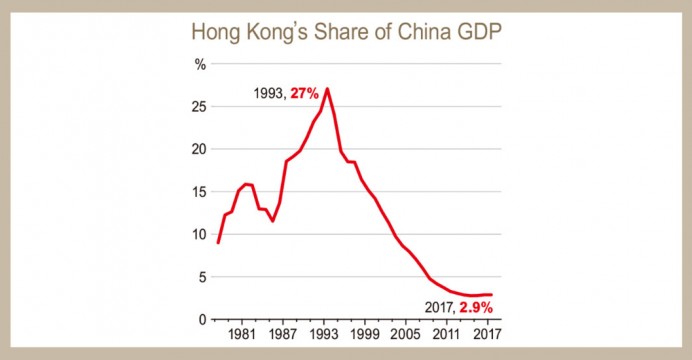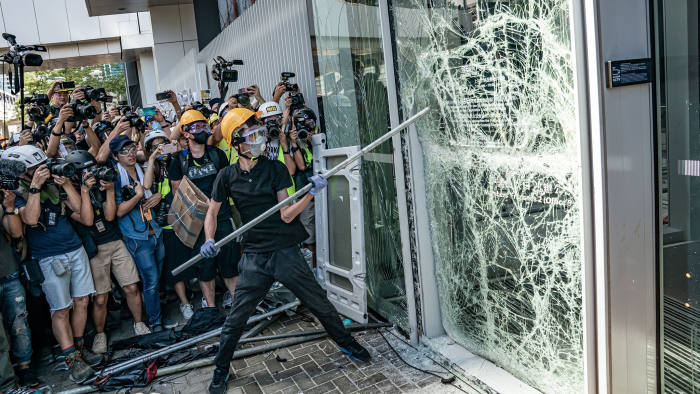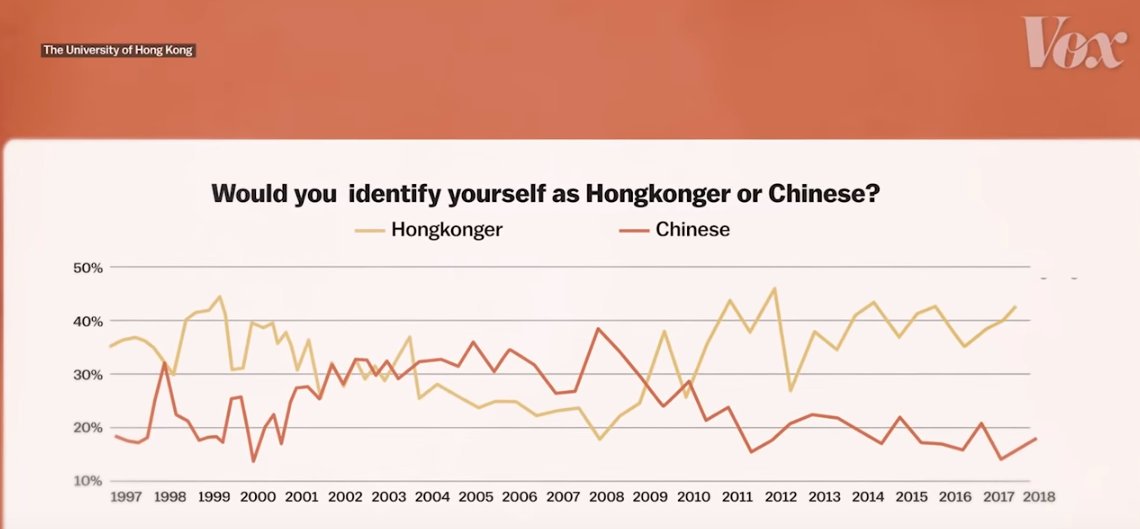
Since June, there have been massive protests in the city of Hong Kong that has 7.3 million population, and a special administrative district in China. The protests are mainly composed of young people. The main demand is democracy, a fair election system, real representation in parliament and the cancellation of a bill that allows for the extradition of criminals to China. A murder case was turned into an opportunity, and the bill was presented to the legislature, allowing Hong Kong to extradite criminals to China. This draft, which triggered actions in which one million people took to the streets, has now been withdrawn.
As the movement continues, Hong Kong has become an arena of propaganda battles between China under Xi Jinping dictate and its notorious rival, the US. But why is this movement in Hong Kong, despite the withdrawal of the law, still carrying out mass protests?
Historical Background of the Tension
Hong Kong remained as a British colony for 156 years until an agreement was signed between Thatcher and Xiaoping in 1997. It was the capital of the trade based on tea and silver exchange of British and Chinese empires. Its culture, political and economic life has been shaped by colonialism. Xiaoping, one of the historical leaders of Maoist China’s smooth transition to the free market, was taking the steps of his embrace with the capitalist world by the handover of Hong Kong with the ’97 agreement. China was on the eve of its great breakthrough. As a financial center in those years, Hong Kong had an economy larger than the quarter of entire China. In 1993, the $120 billion Hong Kong economy was equal to 27 percent of China’s $445 billion economy.
According to the “one state, two systems” agreement signed with United Kingdom, Hong Kong would enjoy “a high degree of autonomy”, and after 2047, it would be under full control of China. The agreement also involved the preservation of the liberal parliamentary system and the structure based on liberal freedoms. But it never happened in reality. Political system is significantly in the hands of China. China and Hong Kong, on the other hand, had two different communities due to this long historical differentiation. China was a machine in which the enormous resources were mobilized in favor of capital, enabling the conditions of intense exploitation owing to the absence of even the most basic human rights under the CPC (Communist Party of China). This is the most important dynamics of China’s rise. And this rise would not be possible without deep nationalist propaganda. In China, unions cannot be organized, workers cannot strike, political parties cannot exist. Therefore, the partial liberal rights in Hong Kong are in serious contradiction with the regime because they are the basis for the emergence of social reaction.
The autonomous administration of Hong Kong is not really autonomous. The people elect only 40 of the 70 members of the LegCo (Legislative Council). The remaining 30 parliamentarians are bourgeois representatives, each of whom belongs to a sector. In parliament, the distribution is mainly between liberals and pro-Chinese politicians. There is no left alternative. Companies and businessmen choose their own representatives. Since all the bourgeois interests in the parliament, where each sector has a seat, such as health, finance and insurance, require faithfulness to the Beijing administration, a distribution of parliament is inconsistent with the political orientation of the people and causes anger. Therefore, those who express themselves as “pro-democracy” become minority in the parliament even though they are the majority of the people. Even the demands for freedom and autonomy within the liberal borders conflicts with the interests of the Hong Kong bourgeoisie. Moreover, the president is elected by the council of representatives and must be approved by Beijing. In short, the Hong Kong political system produces puppet governments.
‘97 Generation on the Street
The generation of 1997, the date of the agreement was signed, is now the dynamic segment of the country. This generation is now on the street because it grew with the increasing tensions of the period when Chinese imperial power has been on the rise. During these years, China has gone beyond perfect adaptation to capitalism, preparing for the goal of being the world’s chief imperial power. Along with the aggressive nationalism of the Xi government, the relationship between Hong Kong and Beijing was further strained. As the system is established in such a way as to hold the majority of Chinese influence, people’s anger is expressed with the discourse of independence against China. An alternative political orientation has not yet been produced. In this context, it is important to note that with the increase in social response, those who identify themselves as Chinese fell over 10% within years, while those who identify themselves as Hong Kongese exceeded 40%. [1]
In 2014, the Umbrella Movement, protesting the electoral system and the political system, mixed with liberal, anti-communist tones and even with Western sympathy, took to the streets. One of the striking differences in the character of the movement since 2014 is the rising popularity of the demand of Hong Kong independence. But historically, this does not seem possible. Because once viewed as liberal “pearl” of the East, Hong Kong is now a tiny island in the gigantic Chinese imperialism.
The Rise of Xi Jinping
The apparatus of the Maoists centralizing bourgeois development in the hands of a bureaucratic apparatus, embraced the markets with Xiaoping government. Today, Xi Jinping is leading the transformation of a gigantic economy and military power to become the greatest imperialist power. China is brutal about minorities and national movements under Xi rule that orders to “be ready for war at any moment” and the resurrect the undisputed leader cult. There is no need to talk about the most basic human rights, such as freedom of thought and organization in China.
The liberal island of Hong Kong, of course, expire for Chinese imperialism. What’s the problem with seizing the city a little before, which will already fall under the rule of China in 2047? For the CPC regime, Hong Kong is nothing but a headache. The once economically strong city is not even 3% of the Chinese economy now, but it is still an important financial center. The material ground, which partially keeps the old autonomy agreement in force, is no longer exist.
China’s “indivisible unity” discourse under Xi has, of course, declared the movement as the actions of foreign powers, traitors and terrorists. It should be noted that the US and Western imperialism are also quick to use the mobilizations as the political claims of the existing tensions with China. Western imperialism is busy with collecting anti-Chinese material for itself. In the West, Hong Kong has always been regarded as the shining star of liberal capitalism against “communist” China.
The Chinese regime is the main force that the people of Hong Kong stand against in the street, where millions are flowing. The concern that the Chinese regime will destroy rights and freedoms brings the masses together. The present movement, which emerges from the heterogeneous combination of different discourses such as independence-autonomy-protection of rights, does not have a political leadership. However, the CPC regime has created a common attitude against communism among the masses. Therefore, the idea of independence becomes identical with the idea of being independent from the so called Communist China. However, another remarkable point is that the youth’s future problems are one of the triggers of this movement.
The Increasing Inequality in Hong Kong
Hong Kong is the third most expensive city in the world. There are serious problems such as dense population and the increasing income gap. At least 20% of Hong Kong population lives below the poverty line. The Chinese economy is experiencing a serious slowdown nowadays. It is almost impossible for other social movements not to emerge. According to Oxfam’s “Hong Kong Inequality Report” data [2], economic inequality in the city is at its peak in the last 45 years. 1.3 million people are in deep poverty. Hundreds of thousands of people live in subdivided rooms like “coffins” under terrible housing conditions.
Such massive actions in one of the cities with the highest inequality gap make the Hong Kong bourgeoisie as frightened as Beijing. They want everything to calm down as soon as possible.At the peak of the protests, the teachers left the schools with their students, meaning they actually carried out strikes. Young people complain about futurelessness in street interviews. In today’s world, there is no such thing as “Western dream” that Hong Kongers can emulate. But the logical conclusion for the independence movement on the street is based on the idea of Westernism, the demand for a Western bourgeois democracy, because of the futurelessness under the authority of “Communist China”. For this reason, apart from the remarkable nature of the movement in terms of revealing the mass reaction, it should not be attributed great political significance to the movement.
The Xi administration afraids that China’s gigantic working-class population will have a possible sympathy for the movement. Chinese media do not show the actions of millions. Because of censorship and CPC propaganda, Chinese nationalists have begun to organize attacks to the protestors. In the protests, the national anthem of Hong Kong is confronted with the national anthem of China. Tensions are climbing in some occasions. Custodies occur in every action and serious police violence is released into the streets. When the police violence is not enough, the gangs are activated. Recently, Chinese nationalists (while the police disappeared for an hour) brutally attacked the activists in a subway station. 45 people were seriously injured. It is clear that this scheme was organized by China and the puppet government.
Xi wants an absolute control in Hong Kong. As there is no extradition in law in force, Chinese regime kidnaps its opponents and puts them on television to “confess” their crimes. Now he wants to carry out this kind of business not de facto but on the legal ground.
Hong Kong is confronted with Chinese nationalism in every field: Every evening, national anthem and videos of national unity are shown before the main newscast. The propaganda in the school books prepared by the CPC makes propaganda that “the multiparty system causes governments to fall and destabilize” is enough to raise concerns about freedom even within liberal boundaries. It is very normal for new generations to fear and develop reactions in this system, as they want freedom and a better life. But the fact that their perspective does not exceed the limits of liberal democracy and bases on Hong Kong nationalism shows that this movement has no way out.
Conclusion
Under the authoritarian Chinese regime in Hong Kong, there are millions of people who express themselves in pro-autonomous or pro-independent discourses today. China accuses the protests of treason while the West turns it into propaganda in its favor. The character of the movement is politically weak and non-directional, not strong enough to change the balances. Even the Hong Kong bourgeoisie is, in essence, attached to the CPC.
Without being against both the CPC regime and the Hong Kong bourgeoisie, or without using working class program which combines class demands with democratic demands and instruments to fight the movement cannot get any success. This necessitates a working-class position that simultaneously confronts the capitalist giant China and the US at the top of capitalism. Yet there is no left organization to organize it. What is more, in the face of China’s commodity empire and financial power, a free future for the people of a small city like Hong Kong can only be possible when the Chinese proletariat get on the stage of history.
[1] https://www.hkupop.hku.hk/english/popexpress/ethnic/eidentity/poll/datatables.html
[2] https://www.oxfam.org.hk/f/news_and_publication/16372/Oxfam_inequality%20report_E













